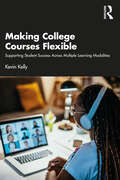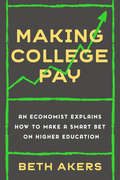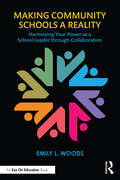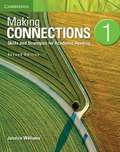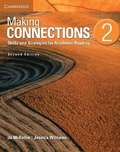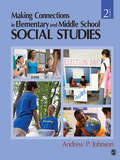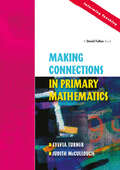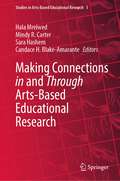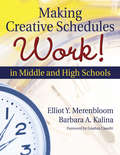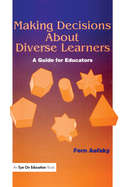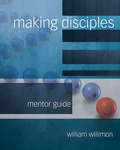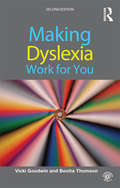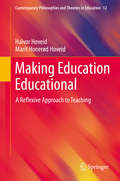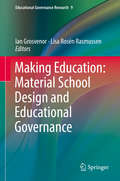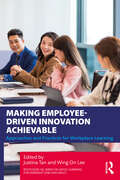- Table View
- List View
Making College Courses Flexible: Supporting Student Success Across Multiple Learning Modalities
by Kevin KellyAddressing students’ increasing demand for flexibility in how they complete college courses, this book prepares practitioners to create equivalent learning experiences for students in the classroom and those learning from home, synchronously or asynchronously. Combining evidence-based strategies and implementation stories shared by veteran practitioners, Kevin Kelly has created a guide for educators who want to offer a more flexible and equitable path to learner success. Chapters address emerging challenges related to teaching, learning, and managing technology, and give recommendations for supporting students in courses that combine two or more participation modalities. Written for busy professionals, readers will be able to quickly identify where to focus their attention and how to put these ideas into practice. Filled with impactful teaching techniques, lessons learned, and immediately applicable exercises, this resource is a powerful tool for creating course experiences that support every student.
Making College Pay: An Economist Explains How to Make a Smart Bet on Higher Education
by Beth AkersA leading economist makes the case that college is still a smart investment, and reveals how to increase the odds of your degree paying off.&“Full of easy-to-understand advice grounded in deep expertise and research.&”—Martin West, William Henry Bloomberg Professor of Education, Harvard UniversityThe cost of college makes for frightening headlines and politics. The outstanding balance of student loans is more than $1.5 trillion nationally, while tuitions continue to rise. And on the heels of a pandemic that nearly dismantled the traditional &“college experience,&” we have to wonder: Is college really worth it?From a financial perspective, the answer is yes, says economist Beth Akers. It&’s true that college is expensive. But once we see higher education for what it is—an investment in future opportunities, job security, and earnings—a different picture emerges: The average college graduate earns a million dollars more over their lifetime, and most four-year schools deliver a 15 percent return on investment—double that of the stock market.Yet these outcomes are not guaranteed. Rather, they hinge upon where and how you opt to invest your tuition dollars. Simply put, the real problem with college isn&’t the cost—it&’s the risk that your investment might not pay off.In Making College Pay, Akers shows how to stack the deck in your favor by making smart choices about where to enroll, what to study, and how to pay for it. You&’ll learn• why choosing the right major matters more than where you enroll• the best criteria for picking a school (hint: not selectivity or ranking)• why there&’s a high cost of working part-time while earning your degree• why it&’s often best to borrow, even if you can afford to pay outright• the pros and cons of nontraditional degree programs• how to take advantage of new, low-risk financing toolsFull of practical advice for students and parents, Making College Pay reminds us that higher education remains an engine for opportunity, upward mobility, and prosperity.
Making Community Schools a Reality: Harnessing Your Power as a School Leader through Collaboration
by Emily L. WoodsWith public demand for community schools on the rise, this timely book provides an empowering, step-by-step approach for school leaders to cultivate community school practices within their schools while simultaneously engaging in the policy advocacy process. This is an actionable toolkit with practical advice, helpful checklists and inventories, as well as real examples from rural and urban schools. Drawing from the experiences of real school leaders involved in community school initiatives, this book illuminates the promise of community schools as centers of the community and sites accessible beyond regular school hours. Community schools bring together educators, local community members, families, and students to provide partnerships that strengthen conditions for student learning and healthy development. Making Community Schools a Reality is a timely and comprehensive resource that helps educational leaders improve learning outcomes and promote equity in their schools.
Making Connections (Second Edition): Level 1 : Skills and Strategies for Academic Reading
by Jessica WilliamsMaking Connections teaches an extensive range of reading skills and strategies in order to prepare students for college reading. <P><P>Making Connections Second edition Level 1 Student's Book introduces first-time readers of academic text to basic reading strategies such as finding paragraph topics, finding supporting details and learning to read quickly.<P> It features a variety of high interest topics including national borders, names, food, sleep, natural disasters, and music.
Making Connections 2: Skills and Strategies for Academic Reading, 2nd Edition
by Jo McentireMaking Connections teaches an extensive range of reading skills and strategies in order to prepare students for college reading. Making Connections Second edition Level 2 Student's Book introduces fundamental reading skills and strategies such as identifying main ideas, interpreting information in charts and graphs, and preparing for reading tests. It features a variety of high-interest topics including news media, education, global business, population growth, fashion and design, and the brain.
Making Connections in Elementary and Middle School Social Studies (2nd Edition)
by Andrew P. JohnsonA practical, holistic approach to integrating social studies with language arts and other content areas This comprehensive, reader-friendly text demonstrates how personal connections can be incorporated into social studies education while meeting standards of the National Council for the Social Studies. Praised for its wealth of strategies that go beyond social studies content teaching—including classroom strategies, pedagogical techniques, activities, and lesson plan ideas—this book presents a variety of methods for new and experienced teachers. Key Features Thinking Ahead invites readers to link their own experiences with the chapter content before reading How Do I? boxes give explicit, step-by-step instruction that demonstrates how to implement and apply the strategies, techniques, and activities described in the chapter Making Connections activities help readers make personal connections with the material New to This Edition The Second Edition has been significantly refined to incorporate new topic coverage and strategies needed by elementary and middle school social studies teachers New sections divide and organize the text into six thematic sections: foundational concepts, planning and assessment, instructional strategies, literacy, teaching subject area content, and enhancing democracy. Differentiating instruction provides an additional focus on students with special needs and differentiating instruction. Additional lesson plans and examples are offered throughout the text.
Making Connections in Literature Grade 8 Student Text
by Bju PressBJU Press’ Grade 8 Making Connections in Literature 4th Edition engages students with a variety of literary selections that follow the themes of Maturity, Wisdom, Generosity, Freedom, and Nature. In the Student Text, chapters ask Big Questions to guide students towards thinking about key literary features and cultural beliefs. Author backgrounds and biographies, defined vocabulary terms, and Before Reading sections prepare students for the literary passages. During Reading and After Reading sections and Think & Discuss questions assist students in analysis, evaluation, and text comparison. Writing assignments with rubrics and oral presentation provide students with opportunities to grow their ability to comprehend and consider the big ideas and biblical application of literature. A novel study on Across Five Aprils (sold separately) is also part of this course.
Making Connections in Primary Mathematics: A Practical Guide
by Sylvia Turner Judith McCullochFirst published in 2004. Routledge is an imprint of Taylor & Francis, an informa company.
Making Connections in and Through Arts-Based Educational Research (Studies in Arts-Based Educational Research #5)
by Mindy R. Carter Hala Mreiwed Sara Hashem Candace H. Blake-AmaranteThis book explores the connections made in and through arts-based educational research through four themes: socially engaged connections, cultural connections, personal and pedagogical connections, and making connections during the COVID-19 pandemic. It emerges from the 3rd bi-annual 2020 Artful Inquiry Research Group symposium on the theme of “connections”. The symposium brought together artists, community members, teachers, students, and researchers through a virtual platform to examine the way(s) in which the arts can help connect people, ideas, and spaces/places in a pandemic reality. Art plays a predominant role in each chapter as authors weave their research and art-based understandings together. This book is a valuable teaching resource for undergraduate and postgraduate courses in teaching, anthropology, digital ethnography, autoethnography, cultural studies, and communications. It is of interest to higher education students, academic researchers, and teachers exploring arts-based methodologies in the fields of creative practice and creativity studies, communications, critical studies, sociology, sciences, teacher education, and the arts.
Making Connections, Intermediate Student's Book: A Strategic Approach to Academic Reading and Vocabulary
by Jessica Williams Jo McentireMaking Connections Intermediate is a reading skills and strategies book that prepares students for college-level reading. It has six high-interest thematic units, each with multiple readings. The readings are written in an accessible academic discourse style, providing practice for intermediate-level students who will eventually need to access authentic academic text.
Making Creative Schedules Work in Middle and High Schools
by Elliot Y. Merenbloom Barbara A. KalinaThis practical, user-friendly resource provides a step-by-step process for restructuring blocks of learning time to improve student-teacher relationships and promote more positive learning experiences.
Making Dance Special
by Melanie PeterFirst Published in 1998. Routledge is an imprint of Taylor & Francis, an informa company.
Making Decisions About Diverse Learners
by Fern AefskyThis book is for building level administrators who work with students (and their families) who have been classified as educationally disabled. It provides practical information about programming options, ranging from self-contained special education classes to inclusive classrooms. It also contains activities, worksheets, and report templates to assist you as you deal with these difficult issues.
Making Disciples: Coordinator's Guide
by William H. WillimonMaking Disciples is a 13-session mentor-based confirmation program that pairs confirmands with adult mentors and guides them through a variety of learning experiences that will strengthen the student's understanding of the faith while connecting him or her with the community of believers in a personal way. It can be used as a stand-alone program, or in conjunction with your current curriculum as a special experiential unit. This is a confirmation program that is more like a process and less like a reading assignment, more engaging and congruent with the nature of the Christian faith than existing programs. Using an "apprenticeship" approach to confirmation Will Willimon produced a series of learning experiences where adult mentors and confirmands are both teachers and learners at the same time.This time-tested approach has been extensively revised and updated for usage in today’s churches that take seriously Christ’s command to be engaged in disciple making The Coordinator’s Guide can be used by the pastor, if that is how your congregation chooses to oversee and support the process of confirmation. However, it’s good to involve as many laypersons as possible in mentoring and guiding. This Coordinator’s Guide is designed to be easily used by a lay coordinator to support the mentors as they guide their confirmands through the journey toward confirmation.Topics explore the basics of Christian faith: •God •Jesus •the Holy Spirit •worship •the Bible •gifts •ministry •baptism •spiritual life •death and resurrection •the church
Making Disciples: Mentor Guide
by William H. WillimonMaking Disciples is a 13-session mentor-based confirmation program that pairs confirmands with adult mentors and guides them through a variety of learning experiences that will strengthen the student's understanding of the faith while connecting him or her with the community of believers in a personal way. It can be used as a stand-alone program, or in conjunction with your current curriculum as a special experiential unit. This is a confirmation program that is more like a process and less like a reading assignment, more engaging and congruent with the nature of the Christian faith than existing programs. Using an "apprenticeship" approach to confirmation Will Willimon produced a series of learning experiences where adult mentors and confirmands are both teachers and learners at the same time.This time-tested approach has been extensively revised and updated for usage in today’s churches that take seriously Christ’s command to be engaged in disciple making The bulk of the Mentor Guide is exactly the same as the Confirmand's Journal. You are encouraged to work through the activities right along with the confirmands and to complete the activities and writing assignments just as he or she does. By working along with your confirmand you will demonstrate the need to keep learning and growing.Topics explore the basics of Christian faith: •God •Jesus •the Holy Spirit •worship •the Bible •gifts •ministry •baptism •spiritual life •death and resurrection •the church
Making Dyslexia Work for You
by Vicki Goodwin Bonita ThomsonWritten for dyslexic adults or anyone who thinks they might be dyslexic, this bold and imaginative book is deliberately concise and easy to dip into. User-friendly, essential guide to the world of study and work for anyone with dyslexia; Identifies the key needs of adults and young people who are dyslexic; Encourages them to put together their own package of ideas and strategies for success; Offers practical activities, examples and support covering reading, memory, organization, self-esteem, IT and dyslexia in the workplace; Over 100 topics from this book are expanded on our online resource. This unique guide to overcoming the day-to-day difficulties associated with dyslexia will also be of great interest to employers, colleagues, teachers, friends and family of those with dyslexia.
Making Education Educational: A Reflexive Approach to Teaching (Contemporary Philosophies and Theories in Education #12)
by Halvor Hoveid Marit Honerød HoveidThis book is an argument for reflexivity in the act of teaching, which means to acknowledge that intention guides the act of teaching. Teaching must create attention towards processes of collectivity in the classroom. Today, teaching is both acts of expressing knowledge and acts of securing justice to all students through a mediation of knowledge. Teaching therefore expresses both knowledge with reference to school subjects, and justice according to the distribution of this knowledge.The authors argue for teaching as the driver of education. To pay attention to teaching is to pay attention to that which is inside the system of education. To consider education as a mediation of knowledge between generations, places teaching as an act of performing the content of education, in a class in a school. The complexity of these processes is easily overlooked when education is used as a means in competitive economies. The approach taken in this text is that deliberations about teaching must be based on historicity. The support for this argument builds on a reading of the French philosopher Paul Ricoeur.The book addresses teaching as an integral part of the learning process. In education today, everything seems to be concentrated around learning, as if teaching no longer takes place. Teachers and teacher educators need a language to discuss and understand teaching, both as personal and institutional actions. A Ricoeurian approach to a discussion on teaching as a reflexive and institutional practice, provides a timely approach to important questions related to teaching in our day and age.
Making Education Fit for Democracy: Closing the Gap
by Brenda WatsonDewey wrote his celebrated book on Democracy and Education over a hundred years ago. Making Education Fit for Democracy asks why education has nevertheless failed to deliver such crucial support for democracy and how it should change to reflect ethical and social responsibilities. It seeks to shed light on what has gone wrong and how it can be put right. Reforming an antiquated system of education should be a matter for public debate. This book is written not only for those currently involved in delivering education, but also for the general public. Arguing that education needs to be holistic, encouraging open-mindedness and developing a wide range of interests, it: Highlights the role of education in supporting democracy Promotes nurture in civilising values over mere information-giving Puts exams and accountability into perspective Seeks to bridge the gulf between schooling and life Argues for the reform of the whole system of education Seeks to use digital technology to personalise education Touching upon several issues currently under debate, such as the rise of populism, the role of religion and narrow subject curriculum, this book will be of interest to all students studying education as well as those involved in teacher education.
Making Education: Material School Design and Educational Governance (Educational Governance Research #9)
by Ian Grosvenor Lisa Rosén RasmussenThis book brings together the notions of material school design and educational governance in the first such text to address this critical interrelationship in any depth. In addressing the issue of governance through analysing current and historical material school designs, it looks at the intersection of politics, economics, aesthetics and pedagogical ideas and practices. More specifically, it explores and unfolds educational governance as it is constituted, materialized and transformed in and through material school designs. It does so by studying a range of issues: from the material and aesthetic language of schooling to the design of the built environment, from spatial organization to the furnishing and equipment of classrooms, and from technologies of regulation to the incorporation of tools of learning. The book presents examples from Europe, Latin and Central America and the United States, and relates to the past, present and future of governance and school design. It focuses on design processes and on designers/architects and people involved in the planning of school design, as well as on school leaders, teachers and pupils adopting, inhabiting and re-shaping them in everyday school life. Furthermore, the book discusses how to study governance by material school design, and how to act upon governance by material design on wishful, actual and ethical terms.
Making Employee-Driven Innovation Achievable: Approaches and Practices for Workplace Learning (Routledge-IAL Series on Adult Learning for Emergent Jobs and Skills)
by Wing On Lee Justina TanThis volume guides workplace trainers in teaching the significance of Employee-Driven Innovation (EDI) and recognising that each and every employee is capable of being the driver of innovation. Given that innovation has become imperative to unlock competitive advantage, and that employees are increasingly regarded as a quintessential aspect of innovation, this focus on EDI and how to enable it is both necessary and opportune. The book is split into three parts: first focusing on helping trainers to address the challenges of getting employees to engage in innovative work besides their regular job tasks. How can organisations instil this mindset in their employees who see themselves as stalwarts of status quo? The book then turns to how organisations can engage employees in innovation, with an accompanying emphasis that the enactment of EDI may not follow a prescribed or planned flow. It then closes by offering real-world examples of the unfolding of EDI in both the Finnish and Singaporean contexts. The book is aimed at educating enterprises, both employers and workplace trainers, and adult educators in the practices and approaches to engage employees in innovation. It seeks to bridge, specifically the theory-practice nexus of EDI, and nudge the enterprises and TAE (training and adult education) practitioners that have yet to involve or engage employees systematically in innovation to seriously consider it.
Making Evaluation Meaningful: Transforming the Conversation to Transform Schools
by P J CaposeyRe-evaluate your perspective on teacher evaluation to truly transform school performance! The tools, strategies, and reflections in this book provide realistic solutions to the problem faced by many schools: meaningless evaluation. A considerable amount of time, energy, and money is spent on the teacher evaluation process, yet the question remains whether it is truly transforming the learning of teachers and, therefore, students. This practical guide shows how evaluation can become the tie that binds all school improvement activities together to: Bring clarity and purpose to all educators making their roles more effective Improve teacher practice since they receive better support Increase student achievement and overall school culture "For years, building leaders have been agonizing over teacher evaluations, pouring countless hours into a practice that consistently fails to produce the desired result; more meaningful conversations that produce improved quality instructional practices and increases in student achievement. In his book, Making Evaluation Meaningful, PJ Caposey shares a step by step framework filled with quick & easy to follow "Tips for Tomorrow," as well as detailed examples to help you shift your mindset and behave yourself to a more effective instructional leader. This book will leave you questioning your own evaluation system while at the same time inspiring you to re-commit the time and resources needed to help grow and develop your teachers." —Jimmy Casas, Principal and CEO " PJ Caposey, through a practitioner lens, has developed an incredible guide that not only helps to demystify the evaluation process, but also provide ready-to- use strategies to ensure reflection and growth are the result. In the end evaluation must be meaningful for both parties. This book will help get you there." —Eric Sheninger, Author/Consultant, Senior Fellow/Thought Leader "PJ Caposey has developed a great resource on teacher evaluation that actually provides realistic, encouraging, and supportive guidance instead of an arbitrary checklist!" —Larry Ferlazzo, Teacher, Author and Education Week Teacher advice blogger Luther Burbank High School, Sacramento, CA
Making Evaluation Meaningful: Transforming the Conversation to Transform Schools
by P J CaposeyRe-evaluate your perspective on teacher evaluation to truly transform school performance! The tools, strategies, and reflections in this book provide realistic solutions to the problem faced by many schools: meaningless evaluation. A considerable amount of time, energy, and money is spent on the teacher evaluation process, yet the question remains whether it is truly transforming the learning of teachers and, therefore, students. This practical guide shows how evaluation can become the tie that binds all school improvement activities together to: Bring clarity and purpose to all educators making their roles more effective Improve teacher practice since they receive better support Increase student achievement and overall school culture "For years, building leaders have been agonizing over teacher evaluations, pouring countless hours into a practice that consistently fails to produce the desired result; more meaningful conversations that produce improved quality instructional practices and increases in student achievement. In his book, Making Evaluation Meaningful, PJ Caposey shares a step by step framework filled with quick & easy to follow "Tips for Tomorrow," as well as detailed examples to help you shift your mindset and behave yourself to a more effective instructional leader. This book will leave you questioning your own evaluation system while at the same time inspiring you to re-commit the time and resources needed to help grow and develop your teachers." —Jimmy Casas, Principal and CEO " PJ Caposey, through a practitioner lens, has developed an incredible guide that not only helps to demystify the evaluation process, but also provide ready-to- use strategies to ensure reflection and growth are the result. In the end evaluation must be meaningful for both parties. This book will help get you there." —Eric Sheninger, Author/Consultant, Senior Fellow/Thought Leader "PJ Caposey has developed a great resource on teacher evaluation that actually provides realistic, encouraging, and supportive guidance instead of an arbitrary checklist!" —Larry Ferlazzo, Teacher, Author and Education Week Teacher advice blogger Luther Burbank High School, Sacramento, CA
Making Faces: Drawing Expressions For Comics And Cartoons
by 8fishChances are, you already know how to draw some expressions. But face it, your stories can only get so far with "happy," "sad" and "angry." In order to give your characters some character, you need to know what they look like when they're about to sneeze, when they smell something stinky or when they're flirting, horrified or completely blotto. Lucky for you, that's what this book is all about! Making Faces contains everything you need to give your characters a wide range of expressions! Part 1: The Basics. How to draw heads, mouths, noses and eyes, and how they change shape when they move.Part 2: The Faces. Over 50 step-by-step demonstrations for a variety of expressions divided into scenarios. Each scenario shows four or five expressions from a single character, from simple emotions to more subtle and complex variations, so you see how a face changes with each emotion. Sidebars illustrate the same expressions on a variety of other characters.Part 3: Storytelling.How to move your story along using expression, point of view, body language and composition. See how it all comes together with damsels in distress, a noir-style interrogation, a Western standoff and other situations. Illustrated with a diverse cast of characters from hobos to superheroes to teenage girls, this guide will help you create the looks that say it all.
Making Faithful Decisions at the End of Life
by Nancy DuffBy exploring the ethics of resisting and accepting death from a Christian perspective, Nancy Duff encourages Christians to talk about death in the context of Christian faith. Making Faithful Decisions at the End of Life helps readers use biblical and theological perspectives regarding death to inform end-of-life decisions, consider where they stand on withdrawing life support and supporting death with dignity laws, and take steps in planning for their own future.
Making Friends PreK3: A Social Skills Program for Inclusive Settings
by Beth Roberts-Pacchione Ruth Herron RossResearch shows that a child's social and behavioral skills affect the development of cognitive and physical abilities. Set students on a path to success and have fun doing it with this newly retitled edition of the popular Wanna Play. The authors provide hundreds of activities that help children learn how to behave appropriately and make friends. Included are tools for teaching emotion regulation, team playing, and body safety to all children, making this resource ideal for use in inclusive settings. New features include: A social interaction checklist for identifying learners' strengths and weaknesses Teacher-friendly activities that can be used in small groups or with the whole class A chapter on teaching emotions and communication skillsStudents with social challenges benefit from direct instruction, and early intervention helps prevent behavior problems and pave the way to academic success. This hands-on guidebook gives teachers, counselors, behavior therapists, and caregivers a wealth of easily implemented and fun-filled ways to enhance children's skills in all areas of social interaction.
